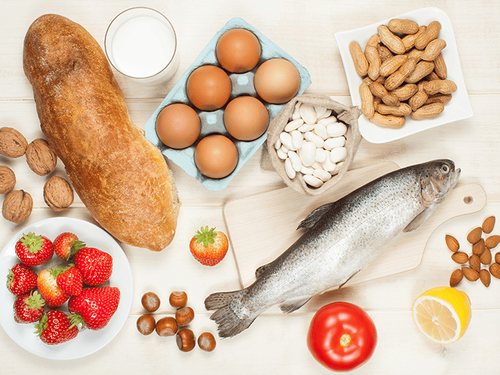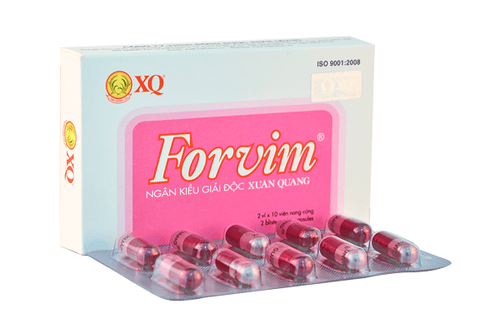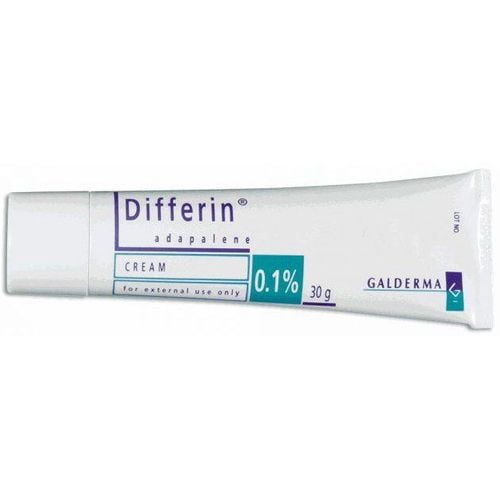This is an automatically translated article.
The article was professionally consulted by Dr. Nguyen Van Dinh - Head of Respiratory - Asthma - Allergy - Clinical Immunology Unit, Vinmec Times City International Hospital.It takes time for a child's immune system to form an immune response to the allergen present in the food. Food allergies rarely occur when first exposed to that food.
1. What is a food allergy?
Food allergy is a symptom of the body's immune system reacting to "foreign" ingredients in food.
Food allergies are more common in children with atopy. Children with atopy are children who often have higher than normal blood levels of IgE antibodies, often have parents or siblings who also have allergies or children with allergic rhinitis, atopic dermatitis , bronchial asthma, allergic urticaria.
In food, there are "foreign" proteins that are allergens (allergens) that, when absorbed into the blood, attach to IgE antibodies to stimulate basophils and mast cells to release chemical mediators such as Histamine, serotonin,... go into the blood, causing allergy symptoms.
Trắc nghiệm: các chỉ số cần chú ý về sự phát triển thể chất của trẻ
Chiều cao, cân nặng của bé ở từng giai đoạn nên là bao nhiêu là bình thường, bao nhiêu là bất thường? Cùng ThS.BS Ma Văn Thấm điểm lại xem bạn đã nắm được các chỉ số phát triển thể chất của bé chưa nhé!The following content is prepared under supervision of Thạc sĩ, Bác sĩ y khoa, Ma Văn Thấm , Nhi , Phòng khám Đa khoa Quốc tế Vinmec Dương Đông(Phú Quốc)
2. Manifestations of food allergies
Allergies can occur minutes or hours after eating. Symptoms of food allergy are often varied, manifesting in many organs such as:
Skin: itchy red rash around the mouth, in the mouth or generalized erythema, edema of the lips, edema around the eyes, edema of the face. Gastrointestinal: nausea, vomiting, abdominal pain, loose stools. Eyes, nose: itchy eyes, watery eyes, itchy nose, runny nose, stuffy nose. In case of severe allergy: there may be glottis edema, bronchospasm (difficulty breathing, stridor), low blood pressure, these symptoms often appear and progress rapidly, seriously endangering the life of children.
Some children develop late symptoms (several days after eating food containing the allergen) including atopic dermatitis, abdominal pain, loose stools or bloody stools.
3. What foods are likely to cause allergies in children?
The foods that cause allergies are peanuts, nuts such as almonds, fish, seafood, eggs (especially egg whites), milk... Milk allergy is the most common food allergy. Children with milk allergy are often very early in life. There are also fruits such as blueberries, pumpkin, tomatoes, potatoes, mustard and food additives such as benzoate, salicylate, monosodium glutamate..

4. What to do when your child has a food allergy?
The principle of allergy treatment is to find out which allergens are the cause of allergies and avoid contact with them. From there, it is necessary to change eating habits and be more careful in using food for children.
It is advisable to consult an allergist when you suspect that your child is allergic to a certain food. The doctor will examine you, ask questions, and may perform some specialized tests, such as an allergen test on your child's skin or a blood test to determine with certainty a food to which a child is allergic.
When a food allergy is confirmed, treatment should be initiated as soon as possible with two primary measures:
Elimination of the allergenic food from the child's diet: Elimination from The child's diet of allergenic foods is a measure of primary importance, in order to reduce the severity and prevent the recurrence of allergic reactions. Use of appropriate medications for allergic conditions: parents should not self-medicate, but need to consult and visit a specialist.
5. How to prevent food allergies in children?

The simplest way to avoid a food allergy is to eliminate the identified allergenic food from the diet. Therefore, before introducing a new food to the child's menu, it is necessary to consult a specialist, especially when there may be cross-allergies between foods.
Once the child has been identified as allergic to a certain food, the mother should not use that food again. It is necessary to avoid tobacco smoke and keep the house clean and cool because cigarette smoke and a polluted living environment make allergies worse for children.
You can give your baby soy milk, cereal-based milk or specially formulated cow's milk (with some special proteins removed) if your baby is allergic to cow's milk. It should be noted that children can still be allergic to buffalo or goat milk if they are allergic to cow's milk.
Before giving children canned or processed foods, it is necessary to read product information carefully to detect foods or additives that have been identified as irritating to children.
In fact, the majority of food allergies in children will change to food intolerance as the child gets older, i.e. the food allergy does not persist for the rest of life, but when should an evaluation be done? Does the child have any food allergies? Or when should a child be reintroduced to a previously suspected allergenic food? These are questions that mothers should see an allergist to consult and evaluate for their children.
Please dial HOTLINE for more information or register for an appointment HERE. Download MyVinmec app to make appointments faster and to manage your bookings easily.















